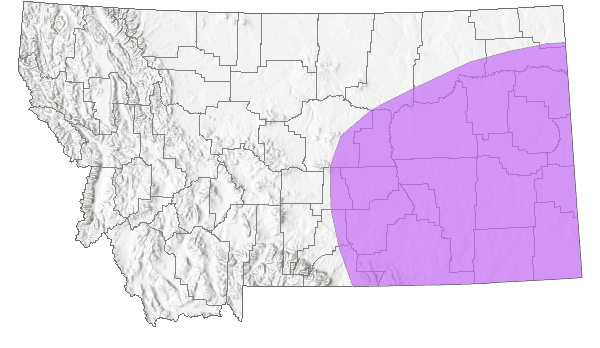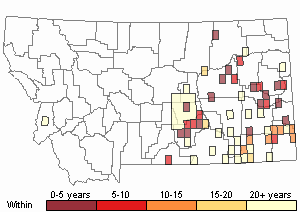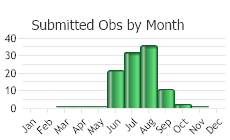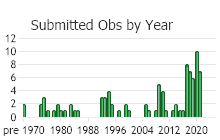View in other NatureServe Network Field Guides
NatureServe
Montana
Utah
Wyoming
Idaho
Wisconsin
British Columbia
South Carolina
Yukon
California
New York
Annual Buckwheat - Eriogonum annuum
Native Species
Global Rank:
G5
State Rank:
S4
(see State Rank Reason below)
C-value:
4
Agency Status
USFWS:
USFS:
BLM:
External Links
State Rank Reason (see State Rank above)
Populations are common and widespread in most of eastern Montana, though population size will fluctuate due to its annual life-cycle.
- Details on Status Ranking and Review
Population Size
ScoreDE - 1000 - 10,000 individuals
Range Extent
ScoreF - 20,000-200,000 sq km (~8,000-80,000 sq mi)
Area of Occupancy
ScoreE - 26-125 4-km2 grid cells
Number of Populations
ScoreC - 21 - 80
Number of Occurrences or Percent Area with Good Viability / Ecological Integrity
ScoreC - Few (4-12) occurrences with excellent or good viability or ecological integrity
Environmental Specificity
ScoreC - Moderate. Generalist or community with some key requirements scarce
Long-term Trend
ScoreU - Unknown
Trends
ScoreU - Unknown
Threats
ScoreD - Low
CommentThreat categories include: Recreational activities.
Intrinsic Vulnerability
ScoreU - Unknown
General Description
Plants: Gray-tomentose, taprooted annuals, biennials (Lesica 2012). Stems 1 to several, erect (Hitchcock et al. 1964), 20–60 cm tall (Lesica 2012).
Leaves: Basal leaves few and withering or falling by anthesis; stem leaves numerous, ascending, overlapping (often strongly so), becoming gradually smaller above (Hitchcock et al. 1964), 1-5 cm in length, oblanceolate (Lesica 2012), mostly alternate with entire margins (McGregor et al. 1986).
Inflorescence: An open cyme (Lesica 2012), branches splitting into two or three parts, the ends slightly spiraled (Hitchcock et al. 1964); bracts triangular; involucres 2–4 mm long with 5 to 6 erect lobes (Lesica 2012) barely 0.5 mm in length, with thick peduncles 1-3 (seldom 5) mm in length or sessile (Hitchcock et al. 1964).
(P. Lesica's contribution adapted from
Lesica et al. 2012. Manual of Montana Vascular Plants. BRIT Press. Fort Worth, TX)
Phenology
Flowering July-September (McGregor et al. 1986).
Species Range
Montana Range
Range Descriptions

 Native
Native
Range Comments
Eastward of and including the foothills of the Rocky Mountains, MT, ND south to NM, TX, and into Mexico (Hitchcock et al. 1964; Lesica 2012).
(P. Lesica's contribution adapted from Lesica et al. 2012. Manual of Montana Vascular Plants. BRIT Press. Fort Worth, TX)
Observations in Montana Natural Heritage Program Database
Number of Observations: 144
(Click on the following maps and charts to see full sized version)
Map Help and Descriptions
Relative Density

Recency



 (Observations spanning multiple months or years are excluded from time charts)
(Observations spanning multiple months or years are excluded from time charts)
Habitat
Ecology
The dense woolly leaves aid the plant in surviving dry periods (Haddock 2007) by protecting the foliage from air movement and thus slowing transpiration.
POLLINATORS The following animal species have been reported as pollinators of this plant species or its genus where their geographic ranges overlap:
Bombus bifarius,
Bombus centralis,
Bombus flavifrons,
Bombus huntii,
Bombus melanopygus,
Bombus mixtus,
Bombus ternarius,
Bombus occidentalis,
Bombus insularis, and
Bombus flavidus (Thorp et al. 1983, Koch et al. 2012, Williams et al. 2014).
Reproductive Characteristics
Flowers: Flowers unisexual (Hitchcock et al. 1964); perianth 1–3 mm long, white to pink, cup-shaped (Lesica 2012), with a connate base, smooth on the outside and woolly on the inside, the outer tepals much wider than the inner (Hitchcock et al. 1964); stamens included (Lesica 2012); ovary smooth (Hitchcock et al. 1964).
Fruit: Achenes 1–2 mm long (Lesica 2012).
(P. Lesica's contribution adapted from
Lesica et al. 2012. Manual of Montana Vascular Plants. BRIT Press. Fort Worth, TX)
Economic Value
Native Americans treated mouth sores and bites from an infusion of this plant. They also rubbed fresh or wetted leaves onto hides for tanning and dyeing (Moerman 1998).)
Management
This species flowers only once before dying (monocarpic). Although often considered an annual, it is likely biennial (Thieret 1964) more often than annual, and possibly a perennial on occasion (Hitchcock et al. 1964).
Pérez et al. (1998) found germination of E. annuum seeds to be low (2% or less) from a seedbank holding high numbers of E. annuum seeds.
It is sometimes considered weedy in the Great Plains (Denver Botanic Gardens) and serves as an indicator of overgrazing (Clements 1920) and disturbance. For example, Hunt and Best (2010) found E. annuum growing more commonly on the highly disturbed soils of abandoned Lesser Prairie-Chicken (Tympanuchus pallidicinctus) leks than on active leks.
Stewardship Responsibility
References
- Literature Cited AboveLegend:
 View Online Publication
View Online Publication Clements, F.E. 1920. Plant indicators: the relation of plant communities to process and practice. Washington, D.C.: Carnegie Institution of Washington. 388 p.
Clements, F.E. 1920. Plant indicators: the relation of plant communities to process and practice. Washington, D.C.: Carnegie Institution of Washington. 388 p. Denver Botanic Gardens: outreach, collaboration and education about the Gardens and their conservation programs. Annual Eriogonum; Annual Buckwheat.
Denver Botanic Gardens: outreach, collaboration and education about the Gardens and their conservation programs. Annual Eriogonum; Annual Buckwheat. Haddock, Mike. October 26, 2007. Kansas Wildflowers & Grasses: information and photos for 849 plant species growing in Kansas. Annual Eriogonum.
Haddock, Mike. October 26, 2007. Kansas Wildflowers & Grasses: information and photos for 849 plant species growing in Kansas. Annual Eriogonum. Hitchcock, C. L., A. Cronquist, M. Ownbey, and J. W. Thompson. 1964. Vascular Plants of the Pacific Northwest. Part 2: Salicaceae to Saxifragaceae. University of Washington Press, Seattle. 597 pp.
Hitchcock, C. L., A. Cronquist, M. Ownbey, and J. W. Thompson. 1964. Vascular Plants of the Pacific Northwest. Part 2: Salicaceae to Saxifragaceae. University of Washington Press, Seattle. 597 pp. Hunt, J.L. and T.L. Best. 2010. Vegetative characteristics of active and abandoned leks of Lesser Prairie-Chickens (Tympanuchus pallidicinctus) in Southeastern New Mexico. The Southwestern Naturalist 55(4):477-487.
Hunt, J.L. and T.L. Best. 2010. Vegetative characteristics of active and abandoned leks of Lesser Prairie-Chickens (Tympanuchus pallidicinctus) in Southeastern New Mexico. The Southwestern Naturalist 55(4):477-487. Koch, J., J. Strange, and P. Williams. 2012. Bumble bees of the western United States. Washington, DC: USDA Forest Service, Pollinator Partnership. 143 p.
Koch, J., J. Strange, and P. Williams. 2012. Bumble bees of the western United States. Washington, DC: USDA Forest Service, Pollinator Partnership. 143 p. Lesica, P., M.T. Lavin, and P.F. Stickney. 2012. Manual of Montana Vascular Plants. Fort Worth, TX: BRIT Press. viii + 771 p.
Lesica, P., M.T. Lavin, and P.F. Stickney. 2012. Manual of Montana Vascular Plants. Fort Worth, TX: BRIT Press. viii + 771 p. McGregor, R.L. (coordinator), T.M. Barkley, R.E. Brooks, and E.K. Schofield (eds). 1986. Flora of the Great Plains: Great Plains Flora Association. Lawrence, KS: Univ. Press Kansas. 1392 pp.
McGregor, R.L. (coordinator), T.M. Barkley, R.E. Brooks, and E.K. Schofield (eds). 1986. Flora of the Great Plains: Great Plains Flora Association. Lawrence, KS: Univ. Press Kansas. 1392 pp. Moerman, D.E. 1998. Native American ethnobotany. Portland, OR: Timber Press, Inc. 927 p.
Moerman, D.E. 1998. Native American ethnobotany. Portland, OR: Timber Press, Inc. 927 p. Pérez, C.J.; S.S. Waller, L.E. Moser, J.L Stubbendieck, and A.A. Steuter. 1998. Seedbank characteristics of a Nebraska Sandhills Prairie. Journal of Range Management 51(1):55-62.
Pérez, C.J.; S.S. Waller, L.E. Moser, J.L Stubbendieck, and A.A. Steuter. 1998. Seedbank characteristics of a Nebraska Sandhills Prairie. Journal of Range Management 51(1):55-62. Thieret, J.W. 1964. Eriogonum annuum (Pologonaceae) biennial in Nebraska. SIDA, Contributions to Botany 1(6):382.
Thieret, J.W. 1964. Eriogonum annuum (Pologonaceae) biennial in Nebraska. SIDA, Contributions to Botany 1(6):382. Thorp, R.W., D.S. Horning, and L.L. Dunning. 1983. Bumble bees and cuckoo bumble bees of California (Hymenoptera: Apidae). Bulletin of the California Insect Survey 23:1-79.
Thorp, R.W., D.S. Horning, and L.L. Dunning. 1983. Bumble bees and cuckoo bumble bees of California (Hymenoptera: Apidae). Bulletin of the California Insect Survey 23:1-79. Williams, P., R. Thorp, L. Richardson, and S. Colla. 2014. Bumble Bees of North America. Princeton, NJ: Princeton University Press. 208 p.
Williams, P., R. Thorp, L. Richardson, and S. Colla. 2014. Bumble Bees of North America. Princeton, NJ: Princeton University Press. 208 p.
- Additional ReferencesLegend:
 View Online Publication
View Online Publication
Do you know of a citation we're missing? Britton, N. L. and A. B. Brown. 1913. An Illustrated Flora of the Northern United States, Canada, and the British Possessions. 2nd Edition in 3 Volumes. New York, NY: Charles Scribner's Sons. B13BRI01PAUS.
Britton, N. L. and A. B. Brown. 1913. An Illustrated Flora of the Northern United States, Canada, and the British Possessions. 2nd Edition in 3 Volumes. New York, NY: Charles Scribner's Sons. B13BRI01PAUS. DuBois, K.L. 1979. An inventory of the avifauna in the Long Pines of Southeastern Montana. M.Sc. Thesis. Bozeman, MT: Montana State University. 113 p.
DuBois, K.L. 1979. An inventory of the avifauna in the Long Pines of Southeastern Montana. M.Sc. Thesis. Bozeman, MT: Montana State University. 113 p. King, L.A. 1980. Effects of topsoiling and other reclamation practices on nonseeded species establishment on surface mined land at Colstrip, Montana. M.Sc. Thesis. Bozeman, MT: Montana State University. 129 p.
King, L.A. 1980. Effects of topsoiling and other reclamation practices on nonseeded species establishment on surface mined land at Colstrip, Montana. M.Sc. Thesis. Bozeman, MT: Montana State University. 129 p. Lesica, P., M.T. Lavin, and P.F. Stickney. 2022. Manual of Montana Vascular Plants, Second Edition. Fort Worth, TX: BRIT Press. viii + 779 p.
Lesica, P., M.T. Lavin, and P.F. Stickney. 2022. Manual of Montana Vascular Plants, Second Edition. Fort Worth, TX: BRIT Press. viii + 779 p. Rennick, R.B. 1981. Effects of prescribed burning on mixed prairie vegetation in southeastern Montana. M.Sc. Thesis. Bozeman, MT: Montana State University. 144 p.
Rennick, R.B. 1981. Effects of prescribed burning on mixed prairie vegetation in southeastern Montana. M.Sc. Thesis. Bozeman, MT: Montana State University. 144 p. Scow, K.L. 1981. Ecological distribution of small mammals at Sarpy Creek, Montana, with special consideration of the Deer Mouse, Peromyscus maniculatus. M.Sc. Thesis. Bozeman, Montana: Montana State University. 73 p.
Scow, K.L. 1981. Ecological distribution of small mammals at Sarpy Creek, Montana, with special consideration of the Deer Mouse, Peromyscus maniculatus. M.Sc. Thesis. Bozeman, Montana: Montana State University. 73 p. Seipel, T.F. 2006. Plant species diversity in the sagebrush steppe of Montana. M.Sc. Thesis. Bozeman, MT: Montana State University. 87 p.
Seipel, T.F. 2006. Plant species diversity in the sagebrush steppe of Montana. M.Sc. Thesis. Bozeman, MT: Montana State University. 87 p. Skilbred, Chester L. 1979. Plant succession on five naturally revegetated strip-mined deposits at Colstrip, Montana. M.Sc. Thesis. Bozeman, MT: Montana State University. 128 pp.
Skilbred, Chester L. 1979. Plant succession on five naturally revegetated strip-mined deposits at Colstrip, Montana. M.Sc. Thesis. Bozeman, MT: Montana State University. 128 pp.
- Web Search Engines for Articles on "Annual Buckwheat"





